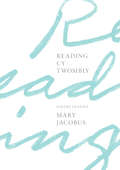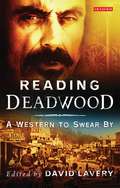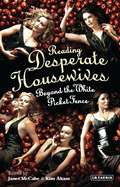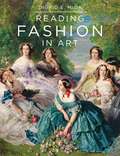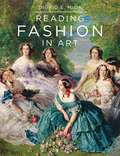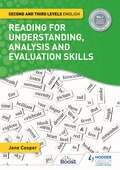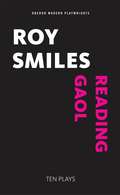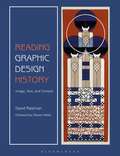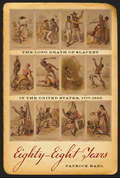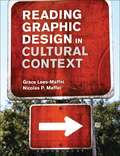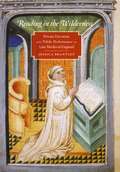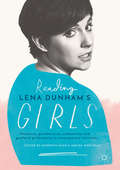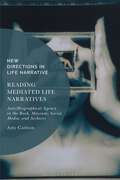- Table View
- List View
Reading Cy Twombly: Poetry in Paint
by Mary JacobusMany of Cy Twombly's paintings and drawings include handwritten words and phrases—naming or quoting poets ranging from Sappho, Homer, and Virgil to Mallarmé, Rilke, and Cavafy. Enigmatic and sometimes hard to decipher, these inscriptions are a distinctive feature of his work. Reading Cy Twombly poses both literary and art historical questions. How does poetic reference in largely abstract works affect their interpretation?Reading Cy Twombly is the first book to focus specifically on the artist’s use of poetry. Twombly’s library formed an extension of his studio and he sometimes painted with a book open in front of him. Drawing on original research in an archive that includes his paint-stained and annotated books, Mary Jacobus’s account—richly illustrated with more than 125 color and black-and-white images—unlocks an important aspect of Twombly’s practice.Jacobus shows that poetry was an indispensable source of reference throughout Twombly’s career; as he said, he "never really separated painting and literature." Among much else, she explores the influence of Ezra Pound and Charles Olson; Twombly’s fondness for Greek pastoral poetry and Virgil’s Eclogues; the inspiration of the Iliad and Ovid’s Metamorphoses; and Twombly’s love of Keats and his collaboration with Octavio Paz.Twombly’s art reveals both his distinctive relationship to poetry and his use of quotation to solve formal problems. A modern painter, he belongs in a critical tradition that goes back, by way of Roland Barthes, to Baudelaire. Reading Cy Twombly opens up fascinating new readings of some of the most important paintings and drawings of the twentieth century.
Reading Deadwood: A Western to Swear By (Reading Contemporary Television)
by David LaveryApart from its brilliance as television, it's amazing what Deadwood gets away with. This acclaimed series from HBO, which premiered in 2004, is set in the teeming outlaw camp of Deadwood. It has been described by Variety as 'a vulgar, gritty, at times downright nasty take on the Old West brimming with all the dark genius that series creator and screenwriter extraordinaire David Milch has at his fingertips'. All this and more. The international cast of authoritative contributors assess Deadwood's many facets: its profane language, its characters, from Al Swearengen (who lives up to his name) and Calamity Jane, to E.B. Farnham and Mr Wu, its place in the western genre, Deadwood and serial fiction, prostitution, the making of American civil society, Deadwood's Chinese, the opening credits, Reverend Smith and much more. Episode and character guides complete the book - the Deadwood companion for fans and studentsto swear by.
Reading 'Desperate Housewives': Beyond the White Picket Fence (Reading Contemporary Television)
by Janet McCabe Kim Akass'Everyone has a little dirty laundry.' The darkly comic series about the secret lives of the ladies living on Wisteria Lane became an instant breakthrough hit for ABC. 21 million viewers tuned in for the first episode and this figure has steadily grown as audiences from around the globe have switched on to the shenanigans in suburbia. Desperate Housewives was subject to a backlash in America, where advertisers on the ABC network were lobbied by Christian groups and Parents' Associations. But the sponsorship withdrawal that resulted did little to dampen the enthusiasm of its legions of fans. Recipient of several awards including the People's Choice Award and Golden Globe for Best Television – Musical or Comedy, Desperate Housewives is a hit. Reading Desperate Housewives offers a critical response to one of the most talked about shows on contemporary television. Leading scholars and writers dissect the appeal of Desperate Housewives, tapping into early reactions and controversy. They consider the American sex wars, contemporary feminism, Republican politics and the rise of the Right, gender and femininity, motherhood and marriage – and that Vanity Fair shoot. The book includes an episode guide tracing all those goings-on beyond that white picket fence.
Reading Digital Fiction: Narrative, Cognition, Mediality (Routledge Interdisciplinary Perspectives on Literature)
by Astrid Ensslin Alice BellReading Digital Fiction offers the first comprehensive and systematic theoretical, methodological, and analytical examination of digital fiction from a cognitive and empirical perspective. Proposing the new concept of “medial reading”, it argues for the centrality of an audience’s interest in, awareness of and/or attention to the medium in which a text is produced and received, and which we argue should be applied to reader data across media. The book analyses and theorises five generations of digital fiction and their reading including hypertext fiction, hypermedia fiction, narrative video games, app fiction, and virtual reality. It showcases medium- and platform-specific methods of qualitative reader response research across a variety of contexts and settings from screen-based and embodied interaction to gallery installation, and from reading group and individual interview to think-aloud methodologies. The book thus addresses the unique affordances of digital fiction reading by designing and reporting on new empirical studies focusing on hypertextuality, interactivity, immersion, as well as medium-specific forms of textual “you”, ontological ambiguity, reader orientation and empathy. In so doing, the book refines, critiques, and expands cognitive, transmedial, and empirical narratology and stylistics by placing the reader of these new narratives front and centre.The Open Access version of this book, available at http://www.taylorfrancis.com, has been made available under a Creative Commons [Attribution-Non Commercial-No Derivatives (CC-BY-NC-ND)] 4.0 license.
Reading Digital Fiction: Narrative, Cognition, Mediality (Routledge Interdisciplinary Perspectives on Literature)
by Astrid Ensslin Alice BellReading Digital Fiction offers the first comprehensive and systematic theoretical, methodological, and analytical examination of digital fiction from a cognitive and empirical perspective. Proposing the new concept of “medial reading”, it argues for the centrality of an audience’s interest in, awareness of and/or attention to the medium in which a text is produced and received, and which we argue should be applied to reader data across media. The book analyses and theorises five generations of digital fiction and their reading including hypertext fiction, hypermedia fiction, narrative video games, app fiction, and virtual reality. It showcases medium- and platform-specific methods of qualitative reader response research across a variety of contexts and settings from screen-based and embodied interaction to gallery installation, and from reading group and individual interview to think-aloud methodologies. The book thus addresses the unique affordances of digital fiction reading by designing and reporting on new empirical studies focusing on hypertextuality, interactivity, immersion, as well as medium-specific forms of textual “you”, ontological ambiguity, reader orientation and empathy. In so doing, the book refines, critiques, and expands cognitive, transmedial, and empirical narratology and stylistics by placing the reader of these new narratives front and centre.The Open Access version of this book, available at http://www.taylorfrancis.com, has been made available under a Creative Commons [Attribution-Non Commercial-No Derivatives (CC-BY-NC-ND)] 4.0 license.
Reading Fashion in Art
by Ingrid E. MidaDress and fashion are central to our understanding of art. From the stylization of the body to subtle textile embellishments and richly symbolic colors, dress tells a story and provides clues as to the cultural beliefs of the time in which artworks were produced. This concise and accessible book provides a step-by-step guide to analysing dress in art, including paintings, photographs, drawings and art installations. The first section of the book includes an introduction to visual analysis and explains how to 'read' fashion and dress in an artwork using the checklists. The second section offers case studies which demonstrate how artworks can be analysed from the point of view of key themes including status and identity, modernity, ideals of beauty, gender, race, globalization and politics. The book includes iconic as well as lesser known works of art, including work by Elisabeth Vigée le Brun, Thomas Gainsborough, James Jacques Tissot, Marcel Duchamp and Man Ray, Yinka Shonibare, Mickalene Thomas, Kent Monkman and many others. Reading Fashion in Art is the perfect text for students of fashion coming to art history for the first time as well as art history students studying dress in art and will be an essential handbook for any gallery visitor. The step-by-step methodology helps the reader learn to look at any work of art that includes the dressed or undressed body and confidently develop a critical analysis of what they see.
Reading Fashion in Art
by Ingrid E. MidaDress and fashion are central to our understanding of art. From the stylization of the body to subtle textile embellishments and richly symbolic colors, dress tells a story and provides clues as to the cultural beliefs of the time in which artworks were produced. This concise and accessible book provides a step-by-step guide to analysing dress in art, including paintings, photographs, drawings and art installations. The first section of the book includes an introduction to visual analysis and explains how to 'read' fashion and dress in an artwork using the checklists. The second section offers case studies which demonstrate how artworks can be analysed from the point of view of key themes including status and identity, modernity, ideals of beauty, gender, race, globalization and politics. The book includes iconic as well as lesser known works of art, including work by Elisabeth Vigée le Brun, Thomas Gainsborough, James Jacques Tissot, Marcel Duchamp and Man Ray, Yinka Shonibare, Mickalene Thomas, Kent Monkman and many others. Reading Fashion in Art is the perfect text for students of fashion coming to art history for the first time as well as art history students studying dress in art and will be an essential handbook for any gallery visitor. The step-by-step methodology helps the reader learn to look at any work of art that includes the dressed or undressed body and confidently develop a critical analysis of what they see.
Reading for Understanding, Analysis and Evaluation Skills: Second and Third Levels English
by Jane CooperSyllabus: CfE (Curriculum for Excellence, from Education Scotland) and SQALevel: BGE S1-3: Third & Fourth LevelsSubject: EnglishCapture pupils' imagination and attention with a rich collection of quality texts, handpicked by Jane Cooper to ensure that pupils want to start reading - and keep reading.Tailored to the interests, motivations and abilities of pupils working towards Second and Third Levels in S1 to S3, this book will help you to close the attainment gap.> Unlock a world of meaning, connection and questioning. Part One teaches the close reading skills that pupils need throughout their lives, with simple explanations, lots of examples and tasks set at three levels - 'Building', 'Strengthening' and 'Extending'.> Apply and develop RUAE skills and monitor progress. Part Two contains ten practice assessments that gradually increase in difficulty, with longer passages, more complex language and more challenging questions.> Save time sourcing non-fiction text extracts. Drawing on her long career as an English teacher and author, Jane Cooper has a talent for knowing which topics pupils will find curious or fun - from the world's cheesiest pizza to a mysterious metal column that appeared in a desert.> Build the foundations for success in National qualifications. With Course Reports showing that N5 and Higher students most commonly lose marks in the RUAE papers, this book offers a proactive solution to building confidence and skills during BGE.> Support the individual needs of every pupil. Providing differentiated, age-appropriate content and tasks, this is the perfect resource for mixed-ability classrooms - especially when used alongside its companion volume, Levels 3-4 English: Reading for Understanding, Analysis and Evaluation Skills.
Reading Gaol (Oberon Modern Playwrights)
by Roy SmilesReading Gaol concerns Oscar Wilde’s imprisonment in Reading Gaol after his infamous court case, persecuted relentlessly by the sadistic and pious prison governor for refusing to admit he is a common criminal. George Bernard Shaw, Frank Harris, Sid Edward Carson and Lord Alfred Douglas appear as Wilde justifies his self-inflicted martyrdom.‘Football is all very well as a game for rough girls, but is hardly suitable for delicate boys’ - Oscar Wilde.
Reading Graphic Design History: Image, Text, and Context
by David RaizmanReading Graphic Design History uses a series of key artifacts from the history of print culture in light of their specific historical contexts. It encourages the reader to look carefully and critically at print advertising, illustration, posters, magazine art direction and typography, often addressing issues of class, race and gender.David Raizman's innovative approach intentionally challenges the canon of graphic design history and various traditional understandings of graphic design. He re-examines 'icons' of graphic design in light of their local contexts, avoiding generalisation to explore underlying attitudes about various social issues. He encourages new ways of reading graphic design that take into account a broader context for graphic design activity, rather than broad views that discourage the understanding of difference and the means by which graphic design communicates cultural values.
Reading Graphic Design History: Image, Text, and Context (Bloomsbury Revelations Ser.)
by David RaizmanReading Graphic Design History uses a series of key artifacts from the history of print culture in light of their specific historical contexts. It encourages the reader to look carefully and critically at print advertising, illustration, posters, magazine art direction and typography, often addressing issues of class, race and gender.David Raizman's innovative approach intentionally challenges the canon of graphic design history and various traditional understandings of graphic design. He re-examines 'icons' of graphic design in light of their local contexts, avoiding generalisation to explore underlying attitudes about various social issues. He encourages new ways of reading graphic design that take into account a broader context for graphic design activity, rather than broad views that discourage the understanding of difference and the means by which graphic design communicates cultural values.
Reading Graphic Design in Cultural Context
by Grace Lees-Maffei Nicolas P. MaffeiReading Graphic Design in Cultural Context explains key ways of understanding and interpreting the graphic designs we see all around us, in advertising, branding, packaging and fashion. It situates these designs in their cultural and social contexts. Drawing examples from a range of design genres, leading design historians Grace Lees-Maffei and Nicolas P. Maffei explain theories of semiotics, postmodernism and globalisation, and consider issues and debates within visual communication theory such as legibility, the relationship of word and image, gender and identity, and the impact of digital forms on design. Their discussion takes in well-known brands like Alessi, Nike, Unilever and Tate, and everyday designed things including slogan t-shirts, car advertising, ebooks, corporate logos, posters and music packaging.
Reading Graphic Design in Cultural Context
by Nicolas P. Maffei Grace Lees-MaffeiReading Graphic Design in Cultural Context explains key ways of understanding and interpreting the graphic designs we see all around us, in advertising, branding, packaging and fashion. It situates these designs in their cultural and social contexts. Drawing examples from a range of design genres, leading design historians Grace Lees-Maffei and Nicolas P. Maffei explain theories of semiotics, postmodernism and globalisation, and consider issues and debates within visual communication theory such as legibility, the relationship of word and image, gender and identity, and the impact of digital forms on design. Their discussion takes in well-known brands like Alessi, Nike, Unilever and Tate, and everyday designed things including slogan t-shirts, car advertising, ebooks, corporate logos, posters and music packaging.
Reading in the Wilderness: Private Devotion and Public Performance in Late Medieval England
by Jessica BrantleyJust as twenty-first-century technologies like blogs and wikis have transformed the once private act of reading into a public enterprise, devotional reading experiences in the Middle Ages were dependent upon an oscillation between the solitary and the communal. In Reading in the Wilderness, Jessica Brantley uses tools from both literary criticism and art history to illuminate Additional MS 37049, an illustrated Carthusian miscellany housed in the British Library. This revealing artifact, Brantley argues, closes the gap between group spectatorship and private study in late medieval England. Drawing on the work of W. J. T. Mitchell, Michael Camille, and others working at the image-text crossroads, Reading in the Wilderness addresses the manuscript’s texts and illustrations to examine connections between reading and performance within the solitary monk’s cell and also outside. Brantley reimagines the medieval codex as a site where the meanings of images and words are performed, both publicly and privately, in the act of reading.
Reading in the Wilderness: Private Devotion and Public Performance in Late Medieval England
by Jessica BrantleyJust as twenty-first-century technologies like blogs and wikis have transformed the once private act of reading into a public enterprise, devotional reading experiences in the Middle Ages were dependent upon an oscillation between the solitary and the communal. In Reading in the Wilderness, Jessica Brantley uses tools from both literary criticism and art history to illuminate Additional MS 37049, an illustrated Carthusian miscellany housed in the British Library. This revealing artifact, Brantley argues, closes the gap between group spectatorship and private study in late medieval England. Drawing on the work of W. J. T. Mitchell, Michael Camille, and others working at the image-text crossroads, Reading in the Wilderness addresses the manuscript’s texts and illustrations to examine connections between reading and performance within the solitary monk’s cell and also outside. Brantley reimagines the medieval codex as a site where the meanings of images and words are performed, both publicly and privately, in the act of reading.
Reading Into Cultural Studies
by Martin Barker Anne Beezer"Reading Into Cultural Studies" revisits a selection of key texts central to the formation of cultural studies as a discipline and as a project. These texts address questions of power, ideology and the possibilities and limits of resistance. Each of the eleven essays in the collection renews an early study in one area of cultural investigation, bringing such seminal texts as "Subculture" by Dick Hebdige, "Loving With a Vengeance" by Tania Modleski and "Bond and Beyond" by Tony Bennett back to the centre of attention, However the essays are not purely celebratory. Each study is critically examined in a number of ways - for its research strategy, its implicit theories of power and ideology, for the empirical evidence it draws on and its conceptual framework. Together, the essays provide an introduction to some of the central debates and issues in cultural studies.
Reading Into Cultural Studies
by Martin Barker Anne Beezer"Reading Into Cultural Studies" revisits a selection of key texts central to the formation of cultural studies as a discipline and as a project. These texts address questions of power, ideology and the possibilities and limits of resistance. Each of the eleven essays in the collection renews an early study in one area of cultural investigation, bringing such seminal texts as "Subculture" by Dick Hebdige, "Loving With a Vengeance" by Tania Modleski and "Bond and Beyond" by Tony Bennett back to the centre of attention, However the essays are not purely celebratory. Each study is critically examined in a number of ways - for its research strategy, its implicit theories of power and ideology, for the empirical evidence it draws on and its conceptual framework. Together, the essays provide an introduction to some of the central debates and issues in cultural studies.
Reading 'The L Word': Outing Contemporary Television (Reading Contemporary Television)
by Kim Akass Janet McCabeThe L Word immediately captured international attention when it debuted on American screens in January 2004. Given its standing as the first television drama series to focus on lesbians,it attracted controversy and devotion from within the lesbian community and beyond - and continues to make headlines and draw an enthusiastic fan base trading gossip through websites and weblogs. The groundbreaking primetime drama from Showtime is about a group of lesbian and bisexual friends living and loving in Los Angeles, and challenges traditionalnotions of relationships, queer lifestyles, gender identities, race and ethnicity, and sex and sexuality. Reading 'The L Word' is the first book about this television phenomenon, and offers a rich variety of explorations of the show and its impact on popular culture.With an Introductionby Sarah Warn, the founder of leading lesbian entertainment website AfterEllen.com, and foreword by Eve Kosofsky Sedgwick, this collection brings together leading academics,feminist critics, scholars and award-winning journalists to discuss The L Word through a range of topics like third-wave feminism, queer theory, bisexuality and sex as well as how TheL Word has been marketed to and received by its audience. There is a complete episode guide as well as a series of interviews with the actors and the writer Guinevere Turner (GoFish). Reading 'The L Word' addresses both humorously and analytically what The L Word says about lesbians-and what both lesbians and straights have to say about The L Word.'A must-read book about the must-see lesbian sex drama that everybody loves but some love to hate.' -Jane Feuer
Reading Lena Dunham’s Girls: Feminism, postfeminism, authenticity and gendered performance in contemporary television
by Meredith Nash Imelda WhelehanIn this book, leading and emerging scholars consider the mixed critical responses to Lena Dunham’s TV series Girls and reflect on its significance to contemporary debates about postfeminist popular cultures in a post-recession context. The series features both familiar and innovative depictions of young women and men in contemporary America that invite comparisons with Sex and the City. It aims for a refreshed, authentic expression of postfeminist femininity that eschews the glamour and aspirational fantasies spawned by its predecessor. This volume reviews the contemporary scholarship on Girls, from its representation of post-millennial gender politics to depictions of the messiness and imperfections of sex, embodiment, and social interactions. Topics covered include Dunham’s privileged role as author/auteur/actor, sexuality, body consciousness, millennial gender identities, the politics of representation, neoliberalism, and post-recession society. This book provides diverse and provocative critical responses to the show and to wider social and media contexts, and contributes to a new generation of feminist scholarship with a powerful concluding reflection from Rosalind Gill. It will appeal to those interested in feminist theory, identity politics, popular culture, and media.
Reading Lena Dunham’s Girls: Feminism, postfeminism, authenticity and gendered performance in contemporary television
by Meredith Nash Imelda WhelehanIn this book, leading and emerging scholars consider the mixed critical responses to Lena Dunham’s TV series Girls and reflect on its significance to contemporary debates about postfeminist popular cultures in a post-recession context. The series features both familiar and innovative depictions of young women and men in contemporary America that invite comparisons with Sex and the City. It aims for a refreshed, authentic expression of postfeminist femininity that eschews the glamour and aspirational fantasies spawned by its predecessor. This volume reviews the contemporary scholarship on Girls, from its representation of post-millennial gender politics to depictions of the messiness and imperfections of sex, embodiment, and social interactions. Topics covered include Dunham’s privileged role as author/auteur/actor, sexuality, body consciousness, millennial gender identities, the politics of representation, neoliberalism, and post-recession society. This book provides diverse and provocative critical responses to the show and to wider social and media contexts, and contributes to a new generation of feminist scholarship with a powerful concluding reflection from Rosalind Gill. It will appeal to those interested in feminist theory, identity politics, popular culture, and media.
Reading London's Suburbs: From Charles Dickens to Zadie Smith
by G. PopeA study of London suburban-set writing, exploring the links between place and fiction. This book charts a picture of evolving themes and concerns around the legibility and meaning of habitat and home for the individual, and the serious challenges that suburbia sets for literature.
Reading Marie al-Khazen’s Photographs: Gender, Photography, Mandate Lebanon (Dress Cultures)
by Yasmine Nachabe TaanThe Lebanese photographer Marie al-Khazen seized every opportunity to use her camera during the years that she was active between 1920 and 1940. She not only documented her travels around tourist sites in Lebanon but also sought creative experimentation with her camera by staging scenes, manipulating shadows, and superimposing negatives to produce different effects in her prints. Within her photographs, bedouins and European friends, peasants and landlords, men and women comfortably share the same space. Her photographs include an intriguing collection portraying her family and friends living their everyday lives in 1920s and '30s Zgharta, a village in the north of Lebanon.Yasmine Nachabe Taan explores these photographs, emphasizing the ways in which notions of gender and class are inscribed within them and revealing how they are charged with symbols of women's emancipation to today's viewers, through women's presence as individuals, separate from family restrictions of that time. Images in which women are depicted smoking cigarettes, driving cars, riding horses, and accompanying men on hunting trips counteract the common ways in which women were portrayed in contemporary Lebanon.
Reading Marie al-Khazen’s Photographs: Gender, Photography, Mandate Lebanon (Dress Cultures)
by Yasmine Nachabe TaanThe Lebanese photographer Marie al-Khazen seized every opportunity to use her camera during the years that she was active between 1920 and 1940. She not only documented her travels around tourist sites in Lebanon but also sought creative experimentation with her camera by staging scenes, manipulating shadows, and superimposing negatives to produce different effects in her prints. Within her photographs, bedouins and European friends, peasants and landlords, men and women comfortably share the same space. Her photographs include an intriguing collection portraying her family and friends living their everyday lives in 1920s and '30s Zgharta, a village in the north of Lebanon.Yasmine Nachabe Taan explores these photographs, emphasizing the ways in which notions of gender and class are inscribed within them and revealing how they are charged with symbols of women's emancipation to today's viewers, through women's presence as individuals, separate from family restrictions of that time. Images in which women are depicted smoking cigarettes, driving cars, riding horses, and accompanying men on hunting trips counteract the common ways in which women were portrayed in contemporary Lebanon.
Reading Mediated Life Narratives: Auto/Biographical Agency in the Book, Museum, Social Media, and Archives (New Directions in Life Narrative)
by Amy CarlsonCalling attention to the unseen mediation and re-mediation of life narratives in online and physical spaces, this ground-breaking exploration uncovers the ever-changing strategies that authors, artists, publishers, curators, archivists and social media corporations adopt to shape, control or resist the auto/biographical in these texts. Concentrating on contemporary life texts found in the material book, museums, on social media and archives that present perceptions of individuality and autonomy, Reading Mediated Life Narratives exposes the traces of personal, cultural, technological, and political mediation that must be considered when developing reading strategies for such life narratives. Amy Carlson asks such questions as what agents act upon these narratives; what do the text, the creator, and the audience gain, and what do they lose; how do constantly evolving technologies shape or stymie the auto/biographical “I”; and finally, how do the mediations affect larger issues of social and collective memory? An examination of the range of sites at which vulnerability and intervention can occur, Carlson does not condemn but stages an intercession, showing us how it is increasingly necessary to register mediated agents and processes modifying the witnessing or recuperation of original texts that could condition our reception. With careful thought on how we remember, how we create and control our pictures, voices, words, and records, Reading Mediated Life Narratives reveals how we construct and negotiate our social identities and memories, but also what systems control us.
Reading Mediated Life Narratives: Auto/Biographical Agency in the Book, Museum, Social Media, and Archives (New Directions in Life Narrative)
by Amy CarlsonCalling attention to the unseen mediation and re-mediation of life narratives in online and physical spaces, this ground-breaking exploration uncovers the ever-changing strategies that authors, artists, publishers, curators, archivists and social media corporations adopt to shape, control or resist the auto/biographical in these texts. Concentrating on contemporary life texts found in the material book, museums, on social media and archives that present perceptions of individuality and autonomy, Reading Mediated Life Narratives exposes the traces of personal, cultural, technological, and political mediation that must be considered when developing reading strategies for such life narratives. Amy Carlson asks such questions as what agents act upon these narratives; what do the text, the creator, and the audience gain, and what do they lose; how do constantly evolving technologies shape or stymie the auto/biographical “I”; and finally, how do the mediations affect larger issues of social and collective memory? An examination of the range of sites at which vulnerability and intervention can occur, Carlson does not condemn but stages an intercession, showing us how it is increasingly necessary to register mediated agents and processes modifying the witnessing or recuperation of original texts that could condition our reception. With careful thought on how we remember, how we create and control our pictures, voices, words, and records, Reading Mediated Life Narratives reveals how we construct and negotiate our social identities and memories, but also what systems control us.
